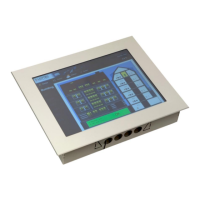L-VIS User Manual 192 LOYTEC
Version 6.2 LOYTEC electronics GmbH
10.4.5 Dynamic Polling in CEA-709
External input NVs in CEA-709 rely on polling. Static polling can be configured by setting
the poll cycle (see Section 10.1.2). In addition, this technology also supports dynamic
polling. When dynamic polling is enabled, polling is only active for those NVs for which an
external OPC client, the current page displayed on the LCD screen, or the current page
displayed on the web interface requires a refresh. See also section 11.5.3 for details on how
to enable dynamic polling for a project.
Dynamic polling has no effect on static or dynamic input NVs. These NVs are supposed to
have bindings and rely on update events. If regular polling is configured via the poll cycle,
no change is made at run-time for dynamic polling.
10.4.6 CEA-709 Data Points in Connections
All types of CEA-709 data points can be used in local and global connections. There is a
special option for SNVT_switch, which allows the state member to be represented as a
binary data point, making it easier to use in connections to other network technology.
10.4.7 Static Interface Changes
The device can be configured to use static NVs. Unlike dynamic NVs, static NVs cannot be
created in the network management tool. They are part of the static interface and are
usually compiled into the device. When static NVs are used, the device changes its static
interface and boots with a new one.
See section 12.3.3 for more information about the procedures which apply when the static
interface of the device is changed.
10.5 BACnet Technology
10.5.1 BACnet Data Points
Data points in the BACnet technology are known as BACnet objects. They have a specific
type (e.g. analog input or binary output) and a set of properties which describe the data
point more closely. The actual value is stored in the property called Present_Value.
On the device, there exist two classes of BACnet data points:
BACnet server objects (SO): These BACnet objects are defined by the
configuration software to be allocated locally on the device. These objects can be
accessed by the BACnet building control system, operating workstations, or other
devices on the BACnet network. They support COV subscriptions to deliver
value changes in an event-driven way. Local server objects can be created as AI,
AO, AV, BI, BO, BV, MI, MO, or MV objects.
BACnet client mappings (CM): Since LVIS devices are used to display and
control values of other devices in the network, they are typically operating as
BACnet clients. This functionality is available through the use of client
mappings. Client mappings can be of the type Poll, COV, Write, Auto or Value.
This specifies how the BACnet client accesses other BACnet objects on the
BACnet network. Poll is used for objects that need to read data from other
BACnet objects in a periodic manner. COV is used to subscribe for COV at other
BACnet objects in order to get updates in an event-driven fashion. Write is used
to send updates to other BACnet objects. Value refers to a combined read and
write client mapping. The Auto setting determines the best fitting method (poll,
COV, or write). When writing a value to this client mapping, the value is written
to the remote BACnet object. As soon as the Present_Value of the remote
BACnet object is updated, the value is transferred back.

